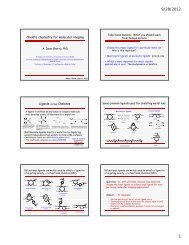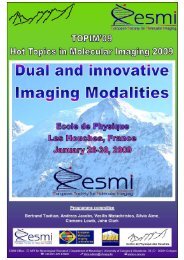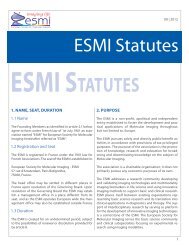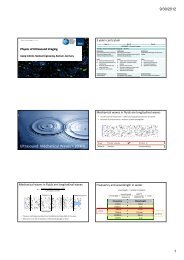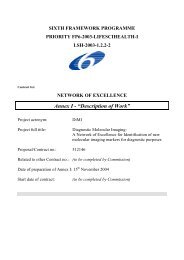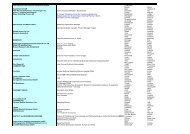5th EuropEan MolEcular IMagIng MEEtIng - ESMI
5th EuropEan MolEcular IMagIng MEEtIng - ESMI
5th EuropEan MolEcular IMagIng MEEtIng - ESMI
Create successful ePaper yourself
Turn your PDF publications into a flip-book with our unique Google optimized e-Paper software.
<strong>5th</strong> <strong>EuropEan</strong> <strong>MolEcular</strong> <strong>IMagIng</strong> <strong>MEEtIng</strong> – EMIM2010<br />
Photochemical activation of endosomal escape of MRI-Gd-agents in tumor cells<br />
Gianolio E. (1) , Arena F. (1) , Hogset A. (2) , Aime S. (3) .<br />
(1) Centro di Imaging Molecolare,<br />
(2) PCI Biotech AS Laboratories,<br />
(3) Molecular Imaging Center, Torino Italy.<br />
eliana.gianolio@unito.it<br />
Introduction: The cellular uptake of xenobiotics often<br />
procedes through the entrapment into endosomes. As<br />
recently reported1,2, in the case of cellular labeling with<br />
Gd-based complexes, the confinment into endosomal<br />
vesicles negatively affects the attainable relaxation enhancement<br />
of water protons. In fact it has been shown<br />
that, upon increasing the number of Gd(III) per cell, a<br />
quenching effect on the observed relaxivity takes place.<br />
It is the consequence of the fact that the term |R1end<br />
– R1cyt| is > than the water exhange rate between the vesicular<br />
and cytosolic compartments. In this communication<br />
we report an efficient method for endosomal escape<br />
of paramagnetic Gd(III) chelates that yields to a marked<br />
improvement of the efficiency in cellular labeling.<br />
Methods: The Photosensitizer TPPS2a (LumiTrans®)<br />
and the Lumisource® lamp were provided by PCI Biotech<br />
AS laboratories (Oslo, Norway). For cellular labeling,<br />
ca. 3-4×106 HTC,K562, NEURO2A and C6 cells<br />
were incubated for 18 hours at 37°C with different concentrations<br />
(5-100mM) of Gd-HPDO3A in the absence<br />
and in the presence of the Photosentisizer (2µl/ml). After<br />
this incubation time cells were washed three times<br />
and incubated for additional 4 hours at 37°C. Then the<br />
cells containing the Photosentisizer were exposed to LumiSource<br />
light for 5 minutes. Then cells were detached,<br />
washed and transferred into glass capillaries for registraion<br />
of MR-images on a Bruker Avance300 spectrometer<br />
operating at 7.1T.<br />
K562 cells<br />
B<br />
K562 cells<br />
A<br />
C<br />
D<br />
E<br />
F<br />
G<br />
R1obs (s -1 )<br />
10<br />
9<br />
8<br />
7<br />
6<br />
5<br />
4<br />
3<br />
2<br />
1<br />
0,0 5,0x10 9<br />
1,0x10 10<br />
Number of Gd 3+ / cell<br />
1,5x10 10<br />
Fig.1: A) T 1 -weighted spin echo images of K562 cells labeled with Gd-HPDO3A. Phantoms E, F<br />
and G contain cells treated with the PCI technology while phantoms B, C, and D contain cells<br />
simply labeled by pynocitotic uptake. B) Observed relaxation rates of cells (HTC stars; NEURO-2a<br />
circles; C6 triangles) labelled with Gd-HPDO3A with endosomic (black symbols) distribution as<br />
a function of the number of Gd(III) found in each cell.<br />
Results: The cellular labeling has been pursued<br />
by pynocitosis (18h at 37°C) at different concentration<br />
of Gd-HPDO3A in the presence and in<br />
the absence of PCI treatment. As shown in the<br />
figure 1A, a marked enhancement in the labeling<br />
efficiency has been observed upon application<br />
of photochemical stimulus to cells entrapping<br />
Gd-HPDO3A and TPPS2a. This considerable<br />
gain in signal intensity achieved when cells are<br />
processed with PCI tehnology is due to the release<br />
of Gd-units from endosomes to cytosol. As<br />
shown in Fig. 1B, the “quenching” effect on the<br />
relaxivity of cells processed with PCI technology<br />
is reached when the number of Gd-HPDO3A per<br />
cell is ca. One order of magnitude higher than the<br />
number causing the same effect when the paramagnetic<br />
complexes are confined into endosomes.<br />
Thus, on going from the endosome-entrapped to<br />
cytoplasm-entrapped Gd(III), the paramagnetic<br />
loading can be several times higher thus allowing<br />
a marked improvement in the MRI detection of<br />
labelled cells.<br />
Conclusions: The PCI methodology appears an<br />
excellent route to pursue the endosomal escape of<br />
Gd-HPDO3A molecules entrapped by pynocitosis<br />
in different types of cells. It as been shown that<br />
it allows to exploit high payload of Gd-HPDO3A<br />
before the quenching effect becomes detectable.<br />
Fig. 1: A) T1-weighted spin echo<br />
Neuro<br />
images of K562 cells Neuro_lumi labeled with<br />
Gd-HPDO3A. Phantoms Htc E, F and G<br />
contain cells treated Htc_lumi with the PCI<br />
C6<br />
technology while phantoms C6_Lumi B,C and<br />
D contain cells simply labeled by<br />
pynocitotic uptake. B) Observed<br />
relaxation rates of cells (HTC stars;<br />
NEURO-2a circles; C6 triangles)<br />
labelled with Gd-HPDO3A with<br />
endosomic (black symbols) or<br />
cytoplasmatic (red symbols)<br />
distribution as a function of the<br />
number of Gd(III) found in each cell.<br />
References:<br />
1. Terreno, E et al., Magnetic<br />
Resonance in Medicine,<br />
2006, 55, 491-497.<br />
2. Strijkers G.J. et al. 2009,<br />
61, 1049-58.<br />
<strong>EuropEan</strong> SocIEty for <strong>MolEcular</strong> <strong>IMagIng</strong> – <strong>ESMI</strong><br />
day1<br />
Parallel Session 4: PROBES - supported by COST



